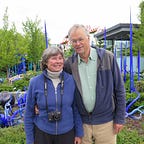Is Vancouver Losing Its Soul?
A wrong turn in the city that showed us how to do tall buildings right
A “dead zone” is taking over the north shore of iconic False Creek as new super high-rises completely ignore the basic human need for congenial spots to gather and play. With the newer tall buildings, human scale is seriously missing.
This is a shame in a city known around the world for its beauty, dynamic culture and tradition of lively public spaces. Its waterfront is revered as a wonderful place to walk and bike. Many other cities have learned lessons from Vancouver ’s lead in many aspects of placemaking, but that wisdom now seems forgotten in its birthplace.
This view shows the north side of False Creek where taller and more anonymous buildings are popping up at an alarming rate. Granville Island in the foreground exemplifies “social life” is at its best, but these newer “place deserts” do not fit with what we come to expect of the Vancouver after visiting frequently over the last 40 years.
Taller new buildings prioritize large drop-off circles and wide parking ramp entrances over all other public uses. Any social or playful activity here can occur only in vehicle spaces, heavily landscaped areas, or limited scraps of open space.
The new False Creek developments need to take a page out of Granville Island’s playbook. It is Canada’s biggest visitor destination after Niagara Falls — thanks to stunning array of cultural facilities, markets, play areas, water activities, restaurants and waterfront views. Some would say it makes up for the lack of social spaces on the north side of False Creek.
The south side of False Creek, with its mix of low rise and mid rise developments is a case study in how a variety of public space types can become a resource for a community. But one new development, Olympic Village sadly misses the mark. We will comment on it in another posting.
